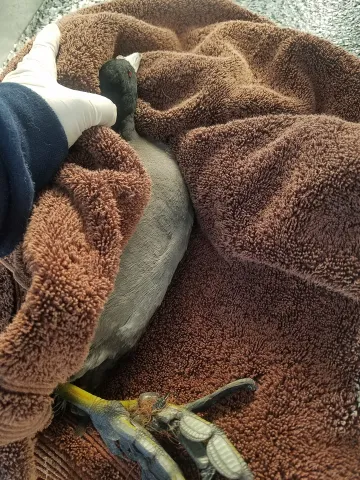Mission Viejo Lake Coot Rescue
While on her daily routine at Lake Mission Viejo, a staffer named Phoebe spotted a bird in distress. After a few minutes, she was able to catch the bird using a towel. She placed the bird in a kennel and contacted the authorities. When an animal services officer arrived at Lake Mission Viejo, he identified the bird as an American Coot that had fishing line wrapped around both feet making it difficult and painful to walk. Some of the fishing line had embedded itself into its left foot causing it to swell and bleed. With the help of some new human friends, the coot was finally free from the fishing line and transferred to Wetlands and Wildlife for rehabilitation. Big shoutout to Phoebe and the officer for helping to save the bird.
Unfortunately, many birds, turtles and marine mammals are injured or killed each year by becoming tangled in fishing line, hooks and tackle that have been improperly disposed of along beaches or thrown from boats into the water.
Here are some things you can do to make sure animals are not harmed by used fishing lines:
- Always cut fishing line into pieces less than 6 inches long (preferably 1-inch). Dispose of it along with hooks and tackle in appropriate covered containers, so it does not blow away or become a risk to wildlife.
- Recycle fishing line. Place all broken or used line in a Monofilament line recycling bin. If no recycling bins are available, place broken or used fishing line that has been cut into pieces in a lidded trash can.
- Monofilament fishing line is recyclable.
- Volunteer your time to clean up fishing line debris at local beaches.
- Use biodegradable fishing line that does not have an indefinite life span in the environment.
- Always check gear and terminal tackle. Inspect your gear often to avoid unwanted breaks. Even small amounts of gear in the water can be harmful to wildlife in entangled or ingested.

